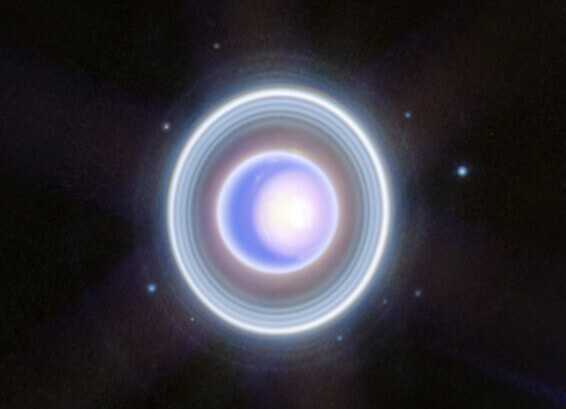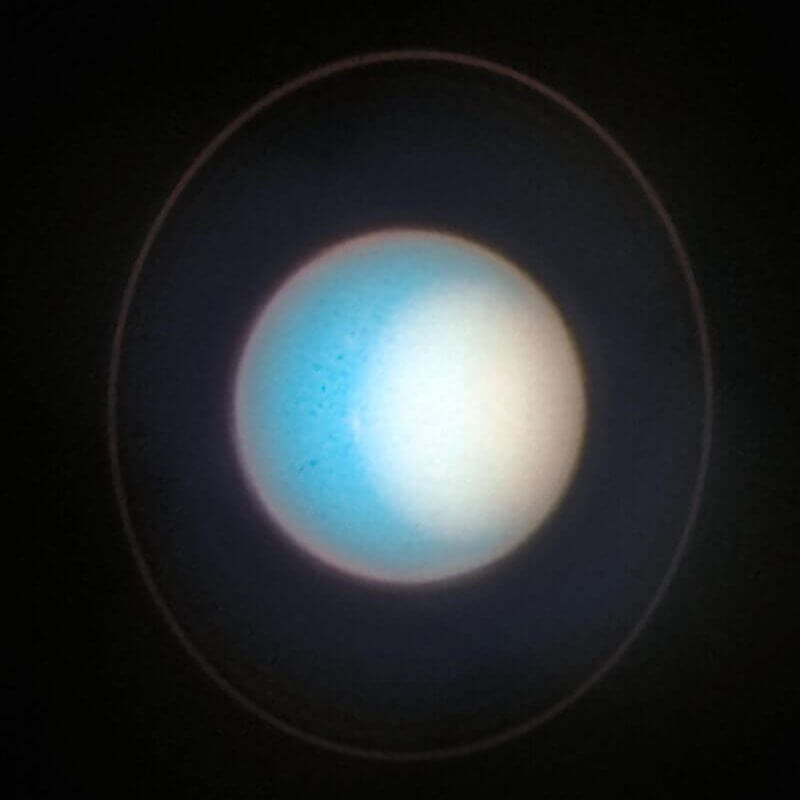(Source: sorae portal to the universe website)
source
- Image credits: NASA, ESA, Canadian Space Agency, STScI
- sorae – The latest images of Uranus observed using the James Webb Space Telescope have been released
- sorae – The latest images of Uranus taken by the Hubble Space Telescope
![[▲ تم رصد أورانوس بواسطة كاميرا الأشعة تحت الحمراء القريبة لتلسكوب جيمس ويب الفضائي (NIRCam) في سبتمبر 2023 (Credit: NASA, ESA, CSA, STScI)]](https://sorae.info/wp-content/uploads/2023/12/Uranus-James-Webb-JWST-NASA-ESA-STScI-weic2332a.jpg)
This image shows the appearance of Uranus as observed on September 4, 2023. The image captures in great detail the body of Uranus, covered in white polar caps, surrounded by multiple bright, faint rings and numerous satellites.
This image was created based on data acquired by the James Webb Space Telescope's Near-Infrared Camera (NIRCam). Because the Webb Space Telescope primarily observes infrared wavelengths that cannot be seen by the human eye, the colors of published images are colored according to the filters used during acquisition.
![[▲ تم تصوير أورانوس بواسطة الكاميرا واسعة النطاق 3 (WFC3) التابعة لتلسكوب هابل الفضائي في نوفمبر 2022 (الائتمان: NASA، ESA، STScI، A. Simon (NASA-GSFC)، MH Wong (UC Berkeley)، J. DePasquale (STScI)]](https://sorae.info/wp-content/uploads/2023/03/Uranus-2022Nov-Hubble-NASA-ESA-STScI-heic2303i.jpg)
![[▲ تم تصوير أورانوس بواسطة الكاميرا واسعة النطاق 3 (WFC3) التابعة لتلسكوب هابل الفضائي في نوفمبر 2022 (الائتمان: NASA، ESA، STScI، A. Simon (NASA-GSFC)، MH Wong (UC Berkeley)، J. DePasquale (STScI)]](https://sorae.info/wp-content/uploads/2023/03/Uranus-2022Nov-Hubble-NASA-ESA-STScI-heic2303i.jpg)
On the other hand, this image of Uranus was taken by the Hubble Space Telescope's Wide Field Camera 3 (WFC3) on November 10, 2022. (Visible Light Imaging)
Uranus is a beautiful, pale blue planet, with its right side covered in a white, hat-like cloud. According to the Space Telescope Science Institute (STScI), which operates the Hubble Space Telescope, this is a photochemically elevated smog-like haze over cities. Many small storms are also said to be visible around the edge of the fog.
In visible light, Uranus appears as a nice pale blue ball, but when viewed at infrared wavelengths (colored according to wavelength), it appears to be a completely different celestial body.
Details about each image of Uranus are provided in the following articles.

New images of Uranus taken by the James Webb Space Telescope have been published
12/23/2023
This is the apparition of Uranus observed on September 4, 2023. The image captures in great detail the body of Uranus, covered in white polar caps, surrounded by multiple faint, bright rings and numerous satellites. …

The latest images of Uranus taken by the Hubble Space Telescope
2023.4.3
NASA and the European Space Agency's Hubble Space Telescope have been making observations of Jupiter, Saturn, Uranus and Neptune every year since 2014 as part of a program to capture changes in the atmospheres of the gas giant planets. …
Read the original article

“Travel maven. Beer expert. Subtly charming alcohol fan. Internet junkie. Avid bacon scholar.”






![Uranus taken using Webb (infrared) and Hubble (visible light)[الصورة الفضائية اليوم]| sorae space portal website](https://sorae.info/wp-content/uploads/2024/03/webb-Hubble-uranus.jpg)
More Stories
5 peripherals that expand the possibilities of innovative PlayStation functions that upend the common sense of home gaming consoles |
5 Techniques to Use “ChatGPT” Wisely on iPhone that Can Also Be Used with Siri |
New and changed features added in ChromeOS 124 |